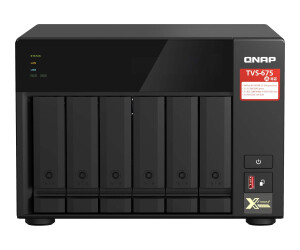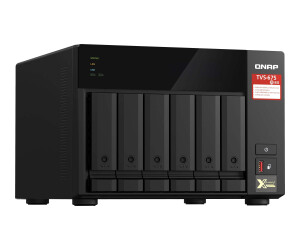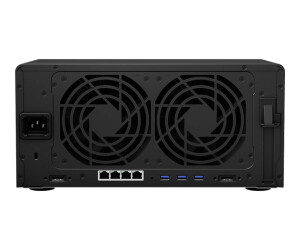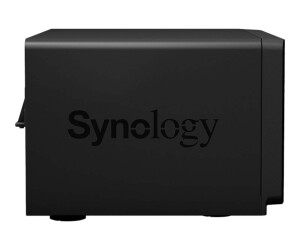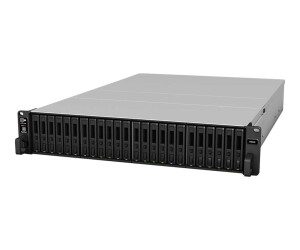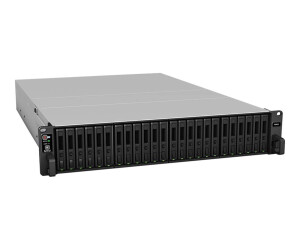NAS systems (Network Attached Storage) have gained significant importance in recent years as they offer an efficient and flexible solution for data storage and management in both businesses and households. With the ever-increasing amount of digital data we generate and use, the need for a reliable and scalable storage solution becomes increasingly crucial. NAS systems precisely meet these requirements by allowing us to store data centrally and access it over the network.
The development of NAS systems has introduced an innovative solution to the aforementioned problems. Instead of storing data on local hard drives or servers, NAS systems enable centralized data storage and network access. This provides a range of benefits, particularly in terms of scalability, availability, and efficiency of data access.
One significant advantage of NAS systems lies in their scalability. In the past, when additional storage was needed, additional hard drives or servers had to be purchased and integrated into the existing infrastructure, which involved significant effort and costs. In contrast, NAS systems allow for easy and cost-effective addition of additional storage space by adding more hard drives to the NAS enclosure or using external NAS expansions. This enables businesses and individuals to keep up with their growing storage needs without making substantial investments in new devices.
Another significant advantage of NAS systems is the improved availability of data. Since the data is stored centrally on the NAS, it can be accessed simultaneously by all authorized users on the network. This facilitates easy collaboration and quick file sharing among different users, regardless of their location. Additionally, NAS systems often offer remote access features, allowing users to access their data outside the local network, such as over the internet. This is especially useful for businesses with remote locations or for users who need to access their files while on the go.
Another aspect that NAS systems enhance is the efficiency of data access. By utilizing a dedicated network connection, data access is accelerated as multiple users can access the NAS simultaneously without interfering with each other. Furthermore, NAS systems often provide advanced features like data prioritization and bandwidth control to ensure that critical applications or users are prioritized, guaranteeing optimal performance. This enables businesses and organizations to streamline their workflows and increase productivity.
Data security is also an important aspect improved by NAS systems. Through the central storage of data on the NAS, regular backups can be performed to prevent data loss due to hardware failures or other issues. Many NAS systems also support RAID (Redundant Array of Independent Disks), a method of distributing data across multiple hard drives to enhance fault tolerance and data integrity. This ensures that even in the event of a hard drive failure, the data remains accessible, and access is not affected.
The physical components of a NAS system include the NAS enclosure and the hard drives contained within it. The enclosure can have various form factors, including tower models or rack-mount enclosures that are mounted in rack cabinets. The number of supported hard drives varies depending on the model and configuration of the NAS system.
In NAS systems, the hard drives are typically operated in a RAID configuration to ensure data integrity and fault tolerance. RAID offers various configurations, such as RAID 0, RAID 1, RAID 5, RAID 6, and RAID 10, each providing different advantages in terms of performance, redundancy, and capacity. The NAS software allows for easy configuration of the desired RAID level and supports disk management, including detection of error states and replacement of faulty drives.
The NAS software is the heart of the system and provides a variety of features for file storage, data management, and backup. It offers a user interface through which administrators can configure and manage the NAS system. Users can set access permissions, create user accounts, and establish network shares for collaborative access through this interface.
File storage is done in the form of shares or folders where users can store their files. These shares can be assigned specific access rights to ensure that only authorized users can access certain files. The NAS software also enables the configuration of access protocols such as SMB (Server Message Block), NFS (Network File System), FTP (File Transfer Protocol), and others to support different devices and operating systems.
The data management features of a NAS system often include advanced search and indexing capabilities to help users quickly find their files. Metadata can be extracted and stored in a database to expedite the search process. Additionally, some NAS systems provide file synchronization and sharing features to facilitate easy file exchange among users.
Data backup is an important aspect of NAS systems. The NAS software often offers built-in backup capabilities, allowing users to create automated backups of their data to external hard drives, other NAS systems, or the cloud. This ensures protection against data loss due to hardware failures, accidental deletion, or other disasters.
Remote access to NAS data is another crucial feature. Users can access their NAS files over the network or the internet using appropriate access rights and authentication methods. This enables remote access from various devices such as computers, laptops, smartphones, and tablets. Some NAS systems also provide dedicated apps or clients for mobile devices to facilitate access and data management on the go.
The scalability of NAS systems is a key factor that contributes to their popularity and effectiveness. Businesses and individuals continuously generate increasing amounts of data, whether through digital documents, multimedia files, or other file formats. The ability to easily and cost-effectively expand the storage capacity of a NAS system makes it an ideal solution to keep up with this growing demand.
Traditionally, expanding storage capacity with conventional local hard drives or servers was a complex and costly affair. It involved purchasing new hard drives, integrating them into the existing system, and possibly setting up a new server. This not only meant high acquisition costs but also required time and effort for configuration and integration.
NAS systems offer a much simpler solution in this regard. They are designed to provide the ability to add additional hard drives as needed to expand storage space. This can be done by installing more hard drives into the NAS enclosure or by connecting external NAS expansions. The NAS software automatically detects the new drives and allows for easy configuration to utilize the expanded storage space.
The scalability of NAS systems often extends beyond the physical expansion of storage space. Many NAS systems also support the addition of NAS expansion units or integration with cloud storage solutions. This allows for seamless expansion of storage space beyond the local network and provides additional flexibility in scaling the system.
In addition, NAS systems often offer advanced features for storage management. This includes the ability to allocate storage space to individual user accounts or shares, ensuring efficient utilization. The NAS software also enables the configuration of storage quotas and data compression to optimize storage space.
The scalability of NAS systems provides businesses and individuals with an economical and flexible solution to meet the ever-growing storage demands. They can incrementally and according to their needs expand storage space without significant investments in new devices. This enables efficient resource utilization and ensures that the NAS system grows alongside changing requirements.
Data security is a central aspect of data storage and management, especially in business environments. NAS systems provide various mechanisms to ensure the security of stored data.
An important feature of NAS systems regarding data security is the ability to create regular backups of the data. With the centralized storage of data on the NAS, it is easy to set up automated backup routines to create a copy of the data on a separate medium. This can be done, for example, on external hard drives, other NAS systems, or in the cloud. Regular backups cover potential data loss scenarios such as hardware failures, human errors, or cyber-attacks.
Another important aspect of data security in NAS systems is the use of RAID technology. RAID allows for distributing data across multiple hard drives to provide redundancy and fault tolerance. There are different RAID levels, including RAID 0, RAID 1, RAID 5, RAID 6, and RAID 10, which offer different approaches to data distribution and redundancy.
For example, RAID 1 (mirroring) allows for storing data on two hard drives simultaneously, so that in case of a drive failure, the data remains accessible. RAID 5 and RAID 6, on the other hand, utilize parity information to distribute data across multiple drives, thereby ensuring fault tolerance. These RAID levels provide protection against drive failures and enable continuous data availability.
Another important aspect of data security in NAS systems relates to data access. NAS systems offer a range of security mechanisms to prevent unauthorized access to the data. This includes the ability to assign access rights at the user or group level and define permissions for shares or individual files. Through careful configuration of access rights, administrators can ensure that only authorized users can access the data.
In addition, many NAS systems provide advanced security features such as the integration of encryption technologies to protect data during transmission and at rest. This ensures that even in the event of physical theft of the NAS device, the data remains protected.
The combination of backup routines, RAID technology, and access controls makes NAS systems a secure solution for storing and managing sensitive data. By implementing these security mechanisms, businesses and individuals can protect their data from loss, unauthorized access, or manipulation while ensuring data integrity.
Remote access to NAS data is a crucial advantage that enhances flexibility and collaboration. NAS systems offer various methods and protocols to enable secure and efficient remote access to stored data.
A common method for remote access is the use of web browsers. The NAS software provides a web-based user interface through which users can access their data from any device with a web browser. By entering the NAS IP address or a custom domain name, users can view, upload, download, and manage their files as if they were stored locally on their device. This method allows users to access their data from anywhere as long as they have an internet connection.
Another approach to remote access of NAS data is using dedicated NAS apps or clients. NAS manufacturers often provide mobile apps for smartphones and tablets that allow users to directly access and manage their NAS data. These apps typically offer a user-friendly interface and advanced features such as streaming multimedia content, file sharing, and data synchronization between devices. This enables users to conveniently access and edit their data even while on the go.
NAS systems also support various network protocols for remote access, including the SMB (Server Message Block) protocol for Windows operating systems and the NFS (Network File System) protocol for Unix-like systems. This allows users to access their NAS files as if they were local files by mounting network drives or network shares in their operating system. This way, users can seamlessly integrate their NAS data into their existing work environments and access it.
When providing remote access, NAS systems place great emphasis on security. Various authentication methods such as username and password, encrypted connections (SSL/TLS), and access permissions help prevent unauthorized access to the data. Additional security features such as two-factor authentication and IP filtering can also be implemented to further enhance security.
Remote access to NAS data enables businesses and individuals to utilize their data flexibly and efficiently. Users can access their data from different devices and locations, enhancing collaboration, data sharing, and productivity. At the same time, the security measures ensure that access to the data is protected and controlled.
Overall, NAS systems provide a cost-effective, flexible, and user-friendly solution for data storage and management. They are suitable for deployment in small home networks as well as large enterprise environments. With the increasing importance of data in our digital world, NAS systems have become an essential tool for protecting our valuable information while enabling efficient access to it. In the following sections, we will delve deeper into the features and benefits of NAS systems and explore some use cases.
Overall, NAS systems provide a cost-effective, flexible, and user-friendly solution for data storage and management. They are suitable for deployment in small home networks as well as large enterprise environments. With the increasing importance of data in our digital world, NAS systems have become an essential tool for protecting our valuable information while enabling efficient access to it.
One main advantage of NAS systems lies in their scalability. Businesses and individuals are generating more and more data, and storage requirements are continuously growing. NAS systems provide the ability to expand storage space as needed by adding additional hard drives without the need for extensive hardware upgrades. This allows users to keep up with their growing storage needs without making significant investments in new devices.
Another crucial advantage of NAS systems is the improved availability of data. With centralized storage on the NAS, users can access their data from different devices and locations. This facilitates collaboration and data sharing among team members in businesses, as well as accessing files while on the go. NAS systems offer various methods for remote access, whether through web browsers, dedicated apps, or network protocols, and ensure that data is transmitted securely and protected.
In addition, NAS systems provide a variety of data management features. Users can organize their data, set up file shares, manage access rights, and even implement specific services such as media servers or cloud synchronization. This makes NAS systems a comprehensive solution for data storage, management, and backup.
Data security also plays an important role in NAS systems. The ability to perform regular data backups and the use of RAID technology ensures protection against data loss due to hardware failures or other issues. NAS systems also offer advanced security features such as access controls, encryption, and authentication methods to prevent unauthorized access to the data.
The applications of NAS systems are diverse. In home networks, they can serve as a central storage location for photos, videos, music, and other personal files accessible to all family members. In small businesses, NAS systems can act as file servers accessible to employees from different locations. They also provide the ability for file sharing and collaboration in editing files.
In larger enterprises, NAS systems can be deployed in advanced environments to provide a scalable and highly available storage solution. They can serve as backup systems to secure critical business data or as media servers for streaming multimedia content within the company. Furthermore, NAS systems can be used in various industries such as media production, healthcare, education, and many others to meet specific data management requirements.
In summary, NAS systems offer an efficient and flexible solution for data storage and management. With their scalability, improved availability, efficient data access, and data security, they are highly beneficial for both businesses and individuals. The combination of physical hardware and powerful software makes NAS systems a versatile and efficient solution for those in need of a scalable, secure, and accessible storage solution.

